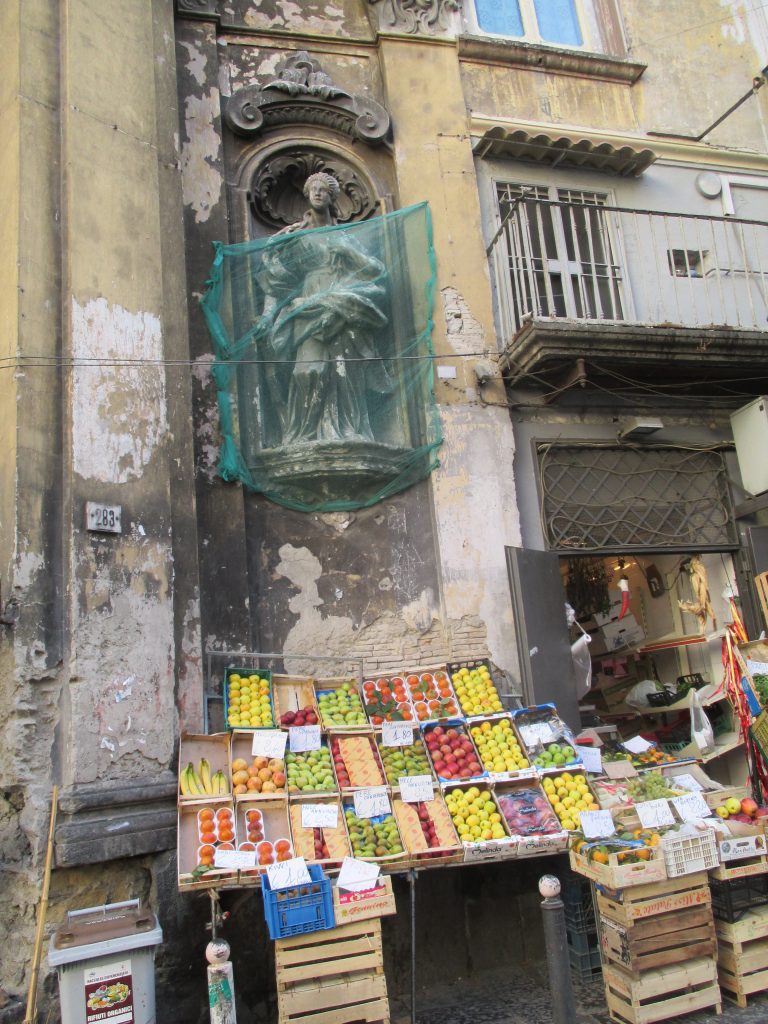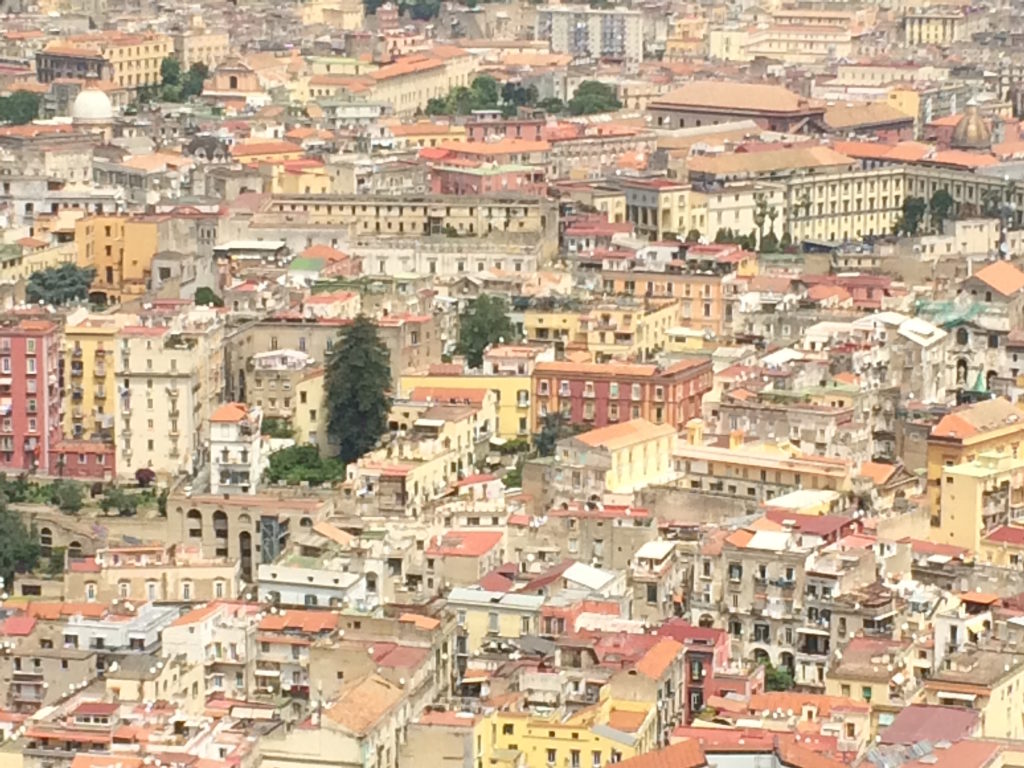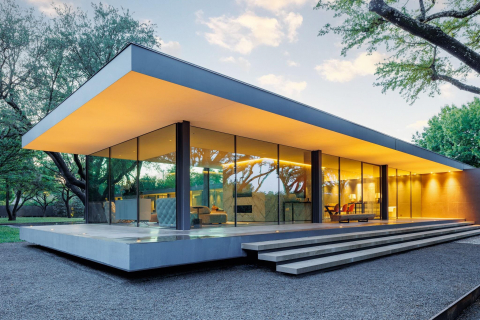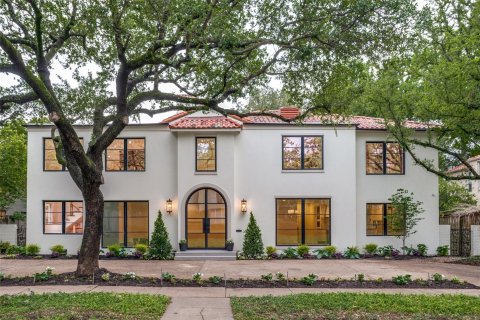A bird's-eye view of Naples from San Martino
This is the fifth installment of photographer and activist Mary Margaret Hansen‘s travel diary as she and fellow artist Earl Staley enjoy an Italian sojourn. Read the previous dispatches here and here. And be sure to scroll through the slideshow above.
Naples feels distant already, perhaps because of our three-hour train ride north to Bologna. More likely, it’s the cultural differences between these two Italian cities that make it seem so far away. Both were once separate countries long before there was a unified Italy. Before we begin to “see” Bologna, I want to remember what I love most about Naples.
Months ago, I persuaded Earl to include Naples in our 2016 itinerary. He allotted six days to this city in the south, because I wanted so much more than the two days we spent there in 2013.
Naples is frenetic, idiosyncratic. Naples is a mess. A mess of scaffolding and “restauro” (under restoration). The city is crumbling, and one wonders if the restoration of so many buildings will ever be completed. Three years ago, I photographed a fruit stand open for business below an angel covered in green netting. On this trip, we noticed that the fruit stand no longer expands into the space below the angel. The angel and its church are covered with plywood and signage describing a restoration process.

“Restauro” did not deter us from experiencing as much of Naples as possible. Let me recount what draws me to the place: First, there is the pulsing energy of the city and the dance-like way that traffic and people move. The streets teem with humans and cars, Vespas and delivery vans. Pedestrians wend their way through traffic as if through tall grass. Neapolitans can walk within inches of moving cars, and drivers allow them this meander to the opposite side of a street. There are few signal lights and no discernible lanes; instead, one experiences rhythms in play. I sense that both drivers and pedestrians feel those rhythms and act on them, moment to moment.
I’ve not seen one fender bender, or the road rage we witness on our city’s streets and freeways. Neapolitans know how to move ever onward on cobblestone streets, narrow and wide.
Secondly, I love the ways Neapolitans talk and gesture. They are loud, emphatic. Their hands and arms are part of the conversation. So many discussion take place on the streets, and we who wander by can hear Neapolitan voices rise and fall, every phrase delivered with emphasis. I wonder how there can be such constant drama. Earl tells me he understood not a word that anyone spoke in Naples. Seems that Neapolitans do not speak the Italian they do in Rome or Bologna or Florence. Neapolitans speak their own language, and if you’ve read Elena Ferrante’s Neapolitan Quartet, you know her characters speak both a dialect and two sorts of Italian.
My favorite pastries, ever, are Neapolitan. They are sublime. Lots of ricotta blended with lemon and subtle flavors I cannot identify. Custards are covered with tiny glazed wild strawberries, cannoli speckled with bits of dried citron and orange, babas swim in liqueur.
We make our selections and watch as the pastries are carefully set on a golden paper tray and wrapped with paper and ribbon. We eat them in the late afternoons, savoring every single bite.
What else do I love about Naples? I love Naples because it is over the top. Intensely Baroque and Rococo. Yes, we saw Baroque in Rome, but Baroque in Naples pushes into Rococo. Rococo filled with soul. The churches, palazzos, cloisters and monasteries are opulent and overdone. Ornamentation pulls at one’s gut.
We visited the Certosa di San Martino, a monastery on which construction began in 1325 and continued for centuries. We could see San Martino, high on its hill, from the sidewalk along the bay. The Carthusian monks commissioned the greatest artists of the time to work on their Certosa (charterhouse), and San Martino holds elaborate treasures. Re-decorated and expanded over several hundred years, the monastery was deconsecrated in the 19th century, and today it is a museum and a place to feel the full force of Neapolitan art and history.
The monastery’s church is, as our guide Pina said, “like walking into a painting.” Entering this place, I could hardly take my eyes off the elaborately patterned marble floor. When, at last, I looked upward, there was more. And more. Carved marble with lapis insets, marble columns, golden angels, saints and martyrs, and then, skyward, the ceiling frescos.
I can become a bit crazed – in a good way – in a place like the Certosa di San Martino. The experience is one of complete visual overload. It is best to stand still and absolutely silent, absorb as much as possible, photograph – if that is the way you take in information – and then move on just a few steps to see again from another vantage point. It is all too much, always another marble pattern or a bevy of painted angels. It was hard to tear myself away.
Earl and I taxied up a second hill for another over-the-top experience at the monumental Museo Nazionale di Capodimonte, set in 300 acres of public green space that was once the hunting grounds for the Bourbon Charles III. This one-time palace holds much of the vast Farnese Collection.
Earl’s eyes lit up as we entered an enormous gallery, its every wall hung with Titian paintings. The real thing.
“So many Titians in one space. One after another,” he marveled.
There were other surprises. The Museo Nazionale has two 16th-century Brueghel paintings, two Goyas, and Caravaggio’s The Flagellation of Christ. A viewer can stand before them as long as it takes to see what one has only known from a slide or a book.
Besides Baroque art, divine pastries and idiosyncratic rhythms, I love Spaccanapoli, the old city center with the longest and straightest street in Naples.
I love this narrow, cobblestone street because it has remained a “neighborhood” for centuries. It is this street where, three years ago on a two-day visit, I took Naples to heart.
Every inch of it is covered with raucous graffiti, crowded with pedestrians and swiftly moving Vespas, filled with shops and restaurants and markets that cater to the folks who live there.
In NapIes, I am a voyeur and will never do more than press my nose against the glass. I see, I exclaim, I love. Naples is a marvelous Baroque tableau. Napoli, città sotto il restauro.











































































_md.png)
















_md.jpeg)



